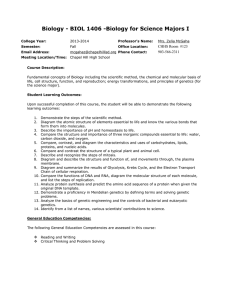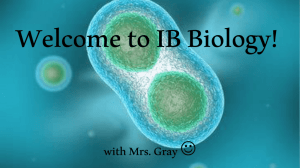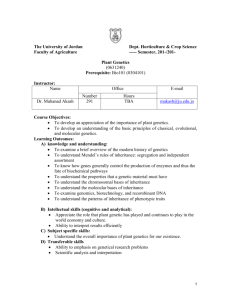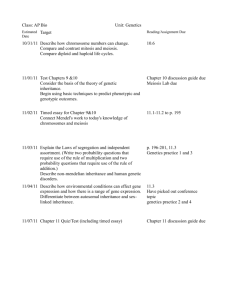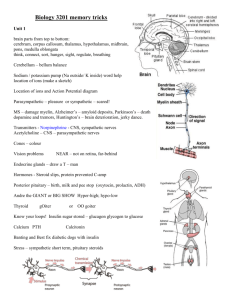Biology AC syllabus
advertisement
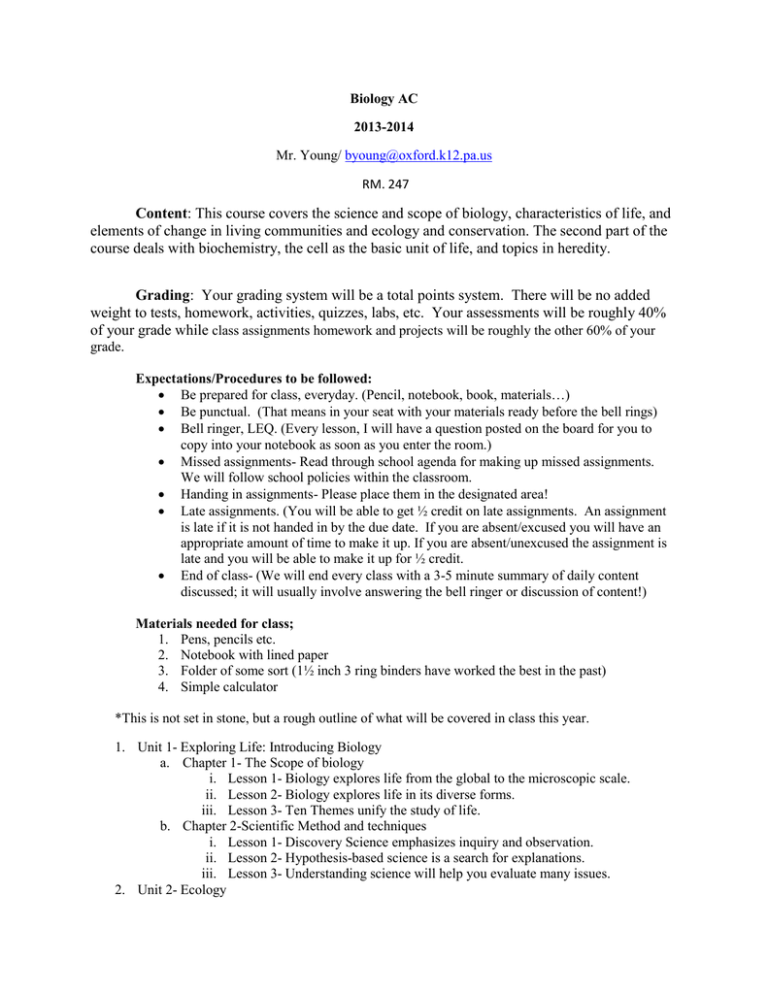
Biology AC 2013-2014 Mr. Young/ byoung@oxford.k12.pa.us RM. 247 Content: This course covers the science and scope of biology, characteristics of life, and elements of change in living communities and ecology and conservation. The second part of the course deals with biochemistry, the cell as the basic unit of life, and topics in heredity. Grading: Your grading system will be a total points system. There will be no added weight to tests, homework, activities, quizzes, labs, etc. Your assessments will be roughly 40% of your grade while class assignments homework and projects will be roughly the other 60% of your grade. Expectations/Procedures to be followed: Be prepared for class, everyday. (Pencil, notebook, book, materials…) Be punctual. (That means in your seat with your materials ready before the bell rings) Bell ringer, LEQ. (Every lesson, I will have a question posted on the board for you to copy into your notebook as soon as you enter the room.) Missed assignments- Read through school agenda for making up missed assignments. We will follow school policies within the classroom. Handing in assignments- Please place them in the designated area! Late assignments. (You will be able to get ½ credit on late assignments. An assignment is late if it is not handed in by the due date. If you are absent/excused you will have an appropriate amount of time to make it up. If you are absent/unexcused the assignment is late and you will be able to make it up for ½ credit. End of class- (We will end every class with a 3-5 minute summary of daily content discussed; it will usually involve answering the bell ringer or discussion of content!) Materials needed for class; 1. Pens, pencils etc. 2. Notebook with lined paper 3. Folder of some sort (1½ inch 3 ring binders have worked the best in the past) 4. Simple calculator *This is not set in stone, but a rough outline of what will be covered in class this year. 1. Unit 1- Exploring Life: Introducing Biology a. Chapter 1- The Scope of biology i. Lesson 1- Biology explores life from the global to the microscopic scale. ii. Lesson 2- Biology explores life in its diverse forms. iii. Lesson 3- Ten Themes unify the study of life. b. Chapter 2-Scientific Method and techniques i. Lesson 1- Discovery Science emphasizes inquiry and observation. ii. Lesson 2- Hypothesis-based science is a search for explanations. iii. Lesson 3- Understanding science will help you evaluate many issues. 2. Unit 2- Ecology a. Chapter 34- The Biosphere i. Lesson 1- The biosphere is the global ecosystem. ii. Lesson 2- Climate determines global patterns in the biosphere. iii. Lesson 3- Biomes are the major types of terrestrial ecosystems. iv. Lesson 4- Aquatic ecosystems make up most of the biosphere. b. Chapter 35- Population and Community Ecology i. Lesson 1- A population is a local group of organism of one species. ii. Lesson 2- There are limits to population growth. iii. Lesson 3- Biologists are trying to predict the impact of human population growth. iv. Lesson 4- Species interact in biological communities. v. Lesson 5- Disturbances are common in communities. 3. Unit 3- Chemistry of Life a. Chapter 4- The Chemical Basis of Life. i. Lesson 1- Life requires about 25 chemical elements. ii. Lesson 2- Chemical properties are based on the structure of atoms. iii. Lesson 3- Chemical bonds join atoms to one another. iv. Lesson 4- Life depends on the unique properties of water. b. Chapter 5- The molecules of life i. Lesson 1- Carbon is the main ingredient of organic molecules. ii. Lesson 2- Carbohydrates provide fuel and building material. iii. Lesson 3- Lipids include fats and steroids. iv. Lesson 4- Proteins perform most functions in cells. v. Lesson 5- Enzymes are proteins that speed up specific reactions in cells. 4. Unit 4- Cell Structure and Function a. Chapter 6- A Tour of the Cell i. Lesson 1- All organisms are made of cells. ii. Lesson 2- Membranes organize a cell’s activity. iii. Lesson 3- Membranes regulate the traffic of molecules. iv. Lesson 4- The cell builds a diversity of products. v. Lesson 5- Chloroplasts and mitochondria energize cells. vi. Lesson 6- An internal skeleton supports the cell and enables movement. b. Chapter 7- The Working Cell: Energy from Food. i. Lesson 1- Sunlight powers life. ii. Lesson 2- Food stores chemical energy. iii. Lesson 3- ATP provides energy for cellular work. iv. Lesson 4- Electrons “fall” from food to oxygen during cellular respiration. v. Lesson 5- Cellular respiration converts energy in food to energy in ATP. vi. Lesson 6- Some cells can harvest energy without oxygen. c. Chapter 8- The Working Cell: Energy from Sunlight. i. Lesson 1-Photosynthesis uses light energy to make food. ii. Lesson 2- The light reactions convert light energy to chemical energy. iii. Lesson 3- The Calvin cycle makes sugar from carbon dioxide. iv. Lesson 4- Photosynthesis has a global impact. Mid-term Review and Exam 5. Unit 5- Genetics a. Chapter 9- Cellular Basis of Inheritance i. Lesson 1- All cells com from cells. ii. Lesson 2- The cell cycle multiplies cells. iii. Lesson 3- Cells divide during the mitotic phase. iv. Lesson 4-Cancer cells grow and divide out of control. v. Lesson 5- Meiosis functions in sexual reproduction. vi. Lesson 6- Meiosis increases genetic variation among offspring. b. Chapter 10- Patterns of Inheritance i. Lesson 1- Genetics developed from curiosity about inheritance. ii. Lesson 2- Mendel discovered that inheritance follows rules of chance. iii. Lesson 3- There are many variations of inheritance patterns. iv. Lesson 4- Meiosis explains Mendel’s principles. v. Lesson 5- Sex-linked traits have unique inheritance patterns. c. Chapter 11- DNA and the Language of Life i. Lesson 1- Genes are made of DNA. ii. Lesson 2- Nucleic acids store information in their sequences of chemical units. iii. Lesson 3- DNA replication is the molecular mechanism of inheritance. iv. Lesson 4- A gene provides the information for making a specific protein. v. Lesson 5- There are two main steps from gene to protein. vi. Lesson 6- Mutations can change the meaning of genes. 6. Unit 6- Biotechnology and Applied Genetics. a. Chapter 12- Human Genetics. i. Lesson 1- The nucleus of a human cell contains an information-rich genome. ii. Lesson 2- Accidents affecting chromosomes can cause disorders. iii. Lesson 3- Mendel’s principles apply to humans. iv. Lesson 4- Genetic changes contribute to cancer. b. Chapter 13- Frontiers of Genetics i. Lesson 1- Biologists have learned to manipulate DNA. ii. Lesson 2- Biologists can engineer bacteria to make useful products. iii. Lesson 3- Biologists can genetically engineer plants and animals. iv. Lesson 4- DNA technologies have many applications. v. Lesson 5- Control mechanisms switch genes on and off. 7. Unit 7- Evolution and Diversity of Life. a. Chapter 14- Evolution: A History and Process. i. Lesson 1- Darwin developed a theory of evolution. ii. Lesson 2- Evolution has left much evidence. iii. Lesson 3- Darwin proposed natural selection as the mechanism of evolution. iv. Lesson 4- Microevolution is a change in a population’s gene pool. v. Lesson 5- Evolutionary biology is important in health science. b. Chapter 15- Origins of Biological Diversity. i. Lesson 1- The diversity of life is based on the origin of new species. ii. Lesson 2- Evolution is usually a remodeling process. iii. Lesson 3- The fossil record provides evidence of life’s history. iv. Lesson 4- Modern taxonomy reflects evolutionary history. v. Wave Erosion *Please see me if you have any questions. Student Signature _________________________________ Parental/Guardian Signature_________________________________
